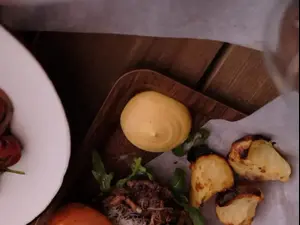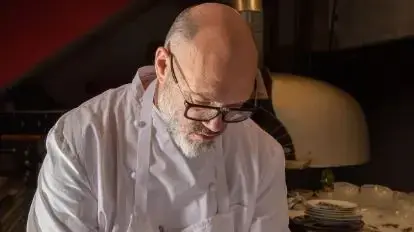Food
Food News
Why is a tomato in toast so hot?
An Israeli scientist finally explained to us
There is no one for whom this has not happened.
There is no one who does not return to the crime scene and be burned again.
No one has been able to understand why.
Up to now
Tags
toast
tomato
toaster
Yaniv Granot
Monday, 22 March 2021, 06:00 Updated: 11:29
Share on Facebook
Share on WhatsApp
Share on general
Share on general
Share on Twitter
Share on Email
0 comments
Dumtok
Pepino, Ein Kinia
A girl makes a steak for her boyfriend - in a controversial way
Food-track bit
Austria Dam Pop-Up
What do cocoa beans look like on the inside?
Chorus
Master Chef Season 9, Michal Ansky, Haim Cohen, Israel ...
A revolutionary method for eating spaghetti bolognese
Danny Abdia with Washington Wizards coach Scott Brooks
Tamar Cohen Tzedek, Project McAllen
Trick for making pizza toast (TikTok / ben_theinternet)
Hundreds of years of mysterious culinary mysteries - including why it is so difficult to make normal French fries in Tel Aviv and when the pitas in the city will decide that price increases have been enough for them - have been assimilated, more or less, into our daily routine.
To the delicious Instagram page of Walla!
I eat
here some phenomenon that is too complicated to understand, occasionally some mixing of substances you would die to know exactly how they learned to speak the same language, and in the end, if you are diligent, maybe some lazy giggle that does not help the solution.
Luckily there is the "big science, in the small", and luckily the association's smart volunteers occasionally deal with the trifles they lived, and explain them better than any search engine.
Or in other words - get Dr. Ella Lachman decomposed through words that we also understand this section with yellow cheese toast and the tomato that never stops boiling inside.
It will drive you crazy
The most surprising and bizarre method we have seen for rapid egg separation
To the full article
"The highest temperature measured on Earth."
Yellow cheese toast (Photo: Giphy)
"You give a bite, and all the software of the sun seems to be poured into your mouth, and why the hell do I have a burn now and I can not taste anything"
"After you baked sourdough bread, and maybe even made cheese from milk and yogurt because there was nothing to see on Netflix, you became hungry. Because you have both bread and cheese - let's say you really invest and it's yellow cheese - and in Tekel's because it's delicious, you make yourself toast , "She wrote in a viral post on the association's Facebook page.
"What do you put in toast? Butter or mayonnaise, a considerable amount of yellow cheese, and also slices of tomato - because tomato is delicious. You heat your toast, maybe in a pan and maybe you have a toaster called 'triangles'. After a while, the bread is crisp, the cheese melts. And the whole business looks very inviting. You're waiting a bit for the toast to cool down, and now the bread is warm to the touch and the cheese is really spinning. You give a bite, and all the sun's software seems to spill into your mouth, and why the hell do I have a burn now and I can taste nothing. Is that the highest temperature measured on Earth was measured in a piece of tomato that someone put in the toast (not really). But why? "
According to Lachman, "To understand this, one must first understand how things heat up and cool down. Heat is a form of energy. This energy can come by moving from something hot, or rolling from another form of energy. For example, friction is a phenomenon in which mechanical energy or "Kinetic rolls into heat energy. When we put our toast in the toaster, we transfer the electrical energy to the heat energy in the toaster (usually by electrical resistance), hoping the toaster will transfer some of that energy to our toast and the toast will heat up."
The Olympic medalist who broke the net
The soy sauce trick that will amaze you
To the full article
"Heat is not temperature."
Lachman's post:
"How do we decide that our toast has warmed up? What determines when the cheese is melted exactly at the desired viscosity? The cheese, or more precisely the components of the cheese, has a certain melting temperature, and when the cheese reaches that temperature it melts," Lachman explained, "but heat is not temperature, though That sometimes we say 'measure heat' and mean measure the temperature of our body. When we heat something, we raise its temperature but the relationship is not direct, but depends on a quantity called 'heat capacity'.
"Like the term 'vessel' or the electric concept of capacity. , Heat capacity is a measure of how much heat energy is needed to raise the temperature of a particular material.
To be a little more precise, we also define the term 'specific heat capacity', which is the amount of heat that must be supplied to a unit of mass of a substance to raise its temperature by one degree Celsius.
"The temperature of a material with a low heat capacity will exceed the temperature of a material with a high heat capacity, if you provide them with the same amount of energy."
"I was shocked, I never thought it would work"
When a professional chef makes a steak at home
To the full article
"Without burning your mouth."
Yellow cheese toast (Photo: Giphy)
"The tomato didn't warm up more than the bread or cheese. But while the bread and cheese cooled to a temperature you could put in your mouth while you waited, the tomato really didn't."
Lachman added that "liquids in general have a higher heat capacity than solids, and among liquids water has a large heat capacity (but not the greatest). This means that in order to heat water to a certain temperature, more energy must be expended than if we were to heat bread, for example. Not only that, because if the heat capacity is high it takes a lot of energy to heat the material up, it also means that the material needs to lose a lot of energy to cool up.
"Now we have come to the solution of the mystery.
When the toast comes out of the toaster, all its ingredients are at the same temperature - that of the toaster - and then, wait for the toast to cool.
Tomatoes have a lot of water.
In addition, the tomato is tucked deep into the cheese and bread so that its heat loss capacity to the environment is not particularly high.
So we have what is ultimately soaked in red with water (yes, this is a very extreme reduction of tomato, but flowed with me here), that we additionally isolated it from the environment by expecting it in melted cheese.
While the bread and cheese cooled a lot, the tomato lost less of the heat they lost, and because of its high heat capacity, even the little heat it lost did not have time to lower its temperature significantly.
"The amusing analogy to the sun core is not really true - the tomato did not heat up more than the bread or cheese. But while the bread and cheese cooled to a temperature you could put in your mouth while you waited, the tomato really did not. The way to add the tomato to your toast "Instead, consider the option of enjoying cool slices of tomato alongside your hot toast, without burning your mouth."
The chefs reveal
This is the best (and most expensive) way to make the perfect steak
To the full article
"That's why we do it."
Breeding less scientific and scientific toasts:
View this post on Instagram
A post shared by Yaniv Granot (@yanivgranot)
"Here I caught two birds with one stone - I also solved the mystery about the tomato, and also on the way readers learned the concept of heat capacity"
A multi-platform transatlantic conversation with Lachman and the people of "Big Science, Small" shed some light on the post and the factors that gave birth to it.
"There are things that are at the forefront of science, and we of course mediate things that excite us in our professional field to readers," she recounted, "but actually the physics around us all the time, and there are phenomena or concepts known to science for a very long time but perhaps unfamiliar to the general public."
"As we write about string theory, or about black holes or topological materials, we also write about why headphones get tangled in your pocket, and even about fluff on your belly," she said.
And what about the tomatoes in the toast?
"Here I caught two birds with one stone - I also solved the mystery about the tomato, and also on the way readers learned the concept of heat capacity. In the comments sometimes there is a more in-depth discussion, because what to do in the real world usually several processes happen together. In general, I really like Our followers and the ability to discuss responses. "
She added that the positive reactions to the post made her very happy, especially the one who said "now I understand what heat capacity is", emphasizing that "that's why we do what we do. Everyone who works for the association does it voluntarily, because we have fun catching people with our enthusiasm From science, and the more people it comes to, the more fun it is. "
The "Science, Big and Small" Association (AR # 580639797) was established with the aim of bridging the gap between the scientific community and the general public directly. and accuracy.
managers association and volunteers are scientists activists or amateurs with advanced degrees in sciences of physics, chemistry, biology and medicine - and the media. everyone who has extensive experience in reading scientific papers and making them accessible to the general public through the Facebook page "big science, big deal" website, and the organization or Participates in scientific events and conferences around the country.
Dr. Ella Lachman is in the midst of a postdoctoral fellowship in the Quantum Materials Laboratory at the Department of Physics at the University of California, Berkeley.
During her doctorate at the Weizmann Institute, she studied the properties of magnetic materials at low temperatures using a magnetic microscope designed and built by her.
Share on Facebook
Share on WhatsApp
Share on general
Share on general
Share on Twitter
Share on Email
0 comments









